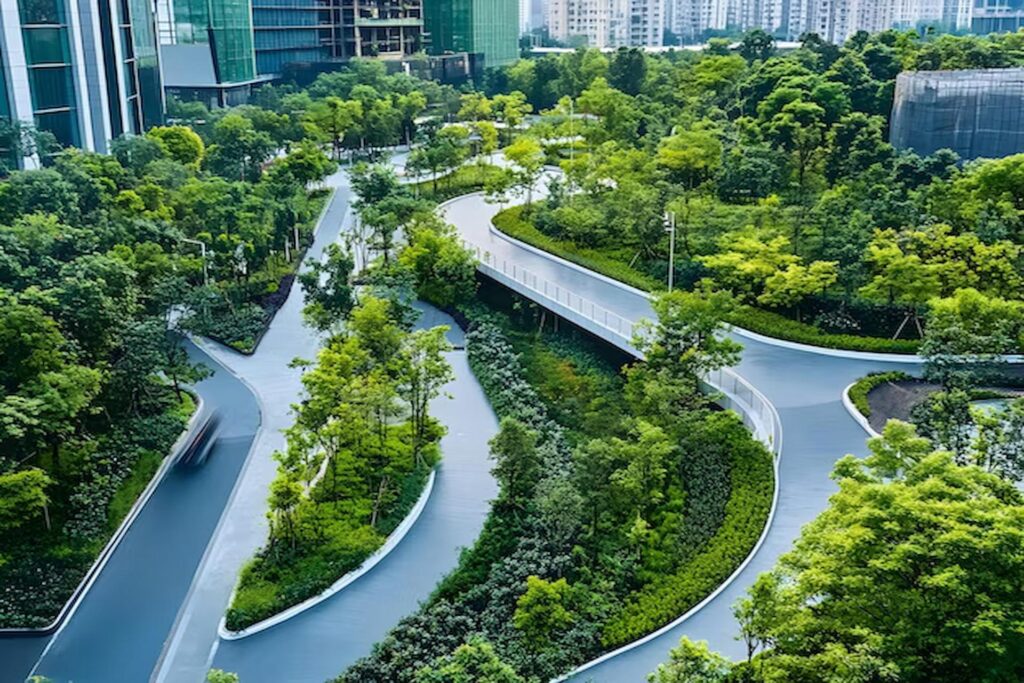Green infrastructure is the key to sustainable urban development. Discover how strategic planning can transform cities into healthier, resilient environments.
Urban areas are expanding unprecedentedly, putting immense pressure on natural resources. As cities grow, so do challenges like flooding, air pollution, and heat islands. Green infrastructure offers a sustainable solution by integrating natural processes into urban planning. It helps manage stormwater, reduces pollution, and improves the quality of life for city dwellers. But to unlock its full potential, cities need effective strategies. This article delves into how to craft these strategies, ensuring environmental, social, and economic benefits.
What is Green Infrastructure?
Green infrastructure refers to a network of natural and semi-natural systems designed to manage water, create healthier urban spaces, and combat climate change; unlike traditional “grey” infrastructure, which relies on pipes and concrete, green infrastructure leverages natural ecosystems.
Examples include:
- Green roofs: Vegetation-covered rooftops that reduce heat and manage rainwater.
- Permeable pavements: Surfaces that allow water to seep through, reducing runoff.
- Urban forests and parks: Green spaces that absorb carbon dioxide and improve air quality.
- Rain gardens and bioswales: Landscaped areas designed to capture and filter stormwater.
These systems are cost-effective, environmentally friendly, and improve cities’ resilience to climate challenges. For instance, Artemis.uk.net offers innovative solutions integrating natural processes into urban planning and enhancing sustainability. Platforms like Green Infrastructure Solutions also provide resources and case studies to help cities implement effective green infrastructure strategies. By adopting these green infrastructure systems, urban areas can better manage stormwater, reduce pollution, and mitigate the effects of climate change.
Why Green Infrastructure Matters: Environmental, Economic, and Social Benefits
1. Environmental Benefits
Green infrastructure is vital for protecting and enhancing ecosystems. It reduces urban heat, improves air and water quality, and supports biodiversity.
- Mitigates climate change: By absorbing carbon dioxide and lowering urban temperatures.
- Reduces flood risks: Natural landscapes absorb rainwater, preventing floods.
- Improves water quality: Filtering stormwater pollutants before reaching rivers and lakes.
2. Economic Benefits
Investing in green infrastructure can lead to significant cost savings over time.
- Lower infrastructure costs: Green systems reduce the need for expensive grey infrastructure upgrades.
- Energy savings: Green roofs and trees reduce cooling costs by providing natural insulation.
- Boosts property values: Homes near green spaces often have higher market value.
3. Social Benefits
Green infrastructure isn’t just about the environment—it enhances people’s quality of life.
- Promotes public health: Cleaner air, cooler environments, and more green spaces reduce respiratory issues and heat-related illnesses.
- Encourages community engagement: Parks and green areas foster social interaction and improve mental health.
- Increases recreational opportunities: Access to nature improves physical activity levels.
Key Principles for Crafting Effective Green Infrastructure Strategies
1. Integrated Planning
Successful green infrastructure requires integrating it into broader urban planning efforts.
- Collaborate across sectors: Coordinate with transportation, housing, and public health departments.
- Align with local goals: Ensure strategies meet community needs and environmental targets.
- Leverage existing assets: Use current green spaces and waterways as foundational elements.
2. Community Involvement
Engaging the community ensures that green infrastructure projects address real needs.
- Host public workshops: Involve residents in the design and planning process.
- Gather feedback: Use surveys to understand community priorities.
- Promote education: Teach the benefits of green infrastructure to build public support.
3. Evidence-Based Decision Making
Data-driven strategies ensure that green infrastructure projects are practical.
- Use GIS mapping: Identify high-risk areas for flooding or heat islands.
- Monitor performance: Regularly assess the environmental and social impacts.
- Adapt strategies: Update plans based on new research and feedback.
Essential Components of Green Infrastructure Strategies
1. Stormwater Management
Green infrastructure helps manage stormwater in ways that mimic natural processes.
- Rain gardens and bioswales: Capture runoff and filter pollutants.
- Green roofs and permeable pavements: Reduce the volume of water entering drainage systems.
- Retention ponds and wetlands: Store excess water during heavy rains.
2. Urban Greening Initiatives
Adding more vegetation to urban areas improves environmental health.
- Planting trees: Provides shade, reduces heat, and absorbs carbon dioxide.
- Creating green corridors: Connects parks and natural areas to support wildlife.
- Developing community gardens: Encourages local food production and strengthens community ties.
3. Sustainable Transportation Infrastructure
Integrating green elements into transportation networks enhances their sustainability.
- Green streets: Incorporate trees and permeable pavements into road designs.
- Bicycle lanes with green buffers: Improve safety and air quality.
- Eco-friendly public transit stops: Use green roofs and solar panels.
Overcoming Challenges in Green Infrastructure Implementation
While the benefits are clear, implementing green infrastructure comes with its challenges.
1. Funding and Resources
Securing financing can be a significant hurdle.
- Public-private partnerships: Collaborate with businesses to fund projects.
- Government grants: Seek out environmental and urban development funding.
- Innovative financing: Use tools like green bonds or stormwater fees.
2. Policy and Regulation Barriers
Outdated regulations can slow progress.
- Update building codes: Encourage green roofs, permeable pavements, and other eco-friendly designs.
- Incentivize developers: Offer tax breaks or grants for sustainable construction.
- Streamline permitting: Make it easier for green projects to gain approval.
3. Maintenance and Longevity
Green infrastructure requires ongoing care to remain effective.
- Establish maintenance plans: Outline responsibilities for upkeep.
- Train local staff: Ensure city workers are equipped to maintain green systems.
- Engage the community: Encourage residents to participate in maintenance efforts.
Final Thoughts
Green infrastructure is essential for creating sustainable, resilient cities. It provides environmental, economic, and social benefits that traditional infrastructure simply cannot match. By integrating green strategies into urban planning, engaging communities, and leveraging data, cities can thrive in the face of climate challenges. A sustainable future starts with thoughtful, well-crafted green infrastructure strategies.

